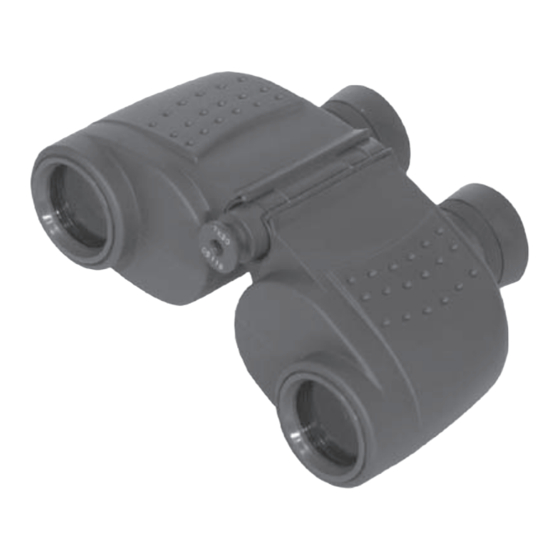
Advertisement
Quick Links
Advertisement

Summary of Contents for ATN 7x30
- Page 1 7x30 Instructions for use and maintenance...
-
Page 2: Table Of Contents
Catalogue Index 1. General Overview ..............(2) 2. Technical Specification ............(2) 3. Construction Specifications ..........(3) 4. How to use a Binocular with a military style reticle ..(6) 5. Binocular and accessories ........... (15) 6. How to care for your binocular .......... (15) -
Page 3: General Overview
1. General Overview 1.1 Main Character This model of 7x30 binoculars is made to military specifications including a range finding reticule. The optics are made to exacting military specif ications in order to give the viewer excel- lent brightness, exacting image clarity and unpar-... -
Page 4: Construction Specifications
Diopter adjusting range: -5~ +7 diopter Interpupillary distance: 56-72 mm Resolution: max 5.5” 2.2 Size and mass Size (length x width x height) : 174mm X 48mm X 110mm Weight Binoculars:max 0.5kg (1.25 lbs) Complete product: max 1.0kg (2.5 lbs) 3. - Page 5 Basic binocular optical construction, as shown in Figure 1, consist of (l)the objective lens, (2) the erecting prisms, (3) the reticle and (4) the eye- piece. The reticle (3) is build in the right system. 3.1.2 How a Binocular works The light from the object or target you are looking at enters the binocular through the Objec- tive lens system (item 1, fig.
- Page 6 Figure 2, illustrates the basic design and str ucture of a por ro prism binocular like the 7x30. The binocular consists of identi- cal two halves. A right side and a left side. Item 1 is the lens assembly including the spe- cial reticle housing.
-
Page 7: How To Use A Binocular With A Military Style Reticle
holding both halves of the binocular is where the objective lens caps are secure. 4. How to use the binocular. 4.1 How to focus the binocular. 4.1.1 Interpupillary adjustment. You must first adjust the binocular so that each eye piece is adjusted to the distance between your eyes. - Page 8 4.1.3 Adjusting for image quality and clarity. Unlike some binoculars that have a center focus to make adjustments this binocular has individual focusing adjustments. In order for you to adjust the optics to your individual eyes, you will need to adjust each eyepiece or ocular. After placing the binocular at your eyes, you will need to close your left eye.
- Page 9 the body. It is reckoned in degrees from either the north or south point clockwise entirely around the horizon. Azimuth of a current is the direction toward which it is f lowing, and is usually reck- oned from the north point. A mil’s reticule can measure the azimuth angle, upper and lower angle, distance and size of an object or target .
- Page 10 zontal direction of the binocular. (Or two ends of one object at horizontal direction) 4.2.2. A When the azimuth of two targets is smaller than the azimuth measuring range (-50 ~ +50 mils) inside the binoculars, aim the scale line at one end of the reticule at the target then read the value of the scale at which another target was located on the reticule.
- Page 11 value from each step is used to obtain the meas- ured azimuth. As shown in fig. 5, the azimuth of target (cr uiser) is 130 mils (60+70 =130). When the azimuth of a target is longer than the azimuth measuring range (-50~1-50 mils) inside the binoc- ulars, you can visually calculate the total azimuth mils by using the vertical line on the reticle by placing the image in a position where the vertical...
- Page 12 image where point B ended after the f irst read- ing. After calculating the mils for each image, You then can add them together to get the total azimuth read-ing.In the (Fig. 5) image below the ship is longer than the total 100 mils available on the reticle.
- Page 13 The value is the measured mils of angle included between the upper and lower parts. As shown in fig. 6, the value of the lower part is 40, the angle included between the upper and lower parts of the target is 0-75 (75mils). 4.2.3.B When the target’s upper and lower parts of the is than the mils on the reticle, it can be measured in steps and the angle can be obtained...
- Page 14 observer and the target using the formula. For example: There is an adult whose height is 1.70m. (H= 1.70m) The upper and lower angle of the adult is 0 - 40 mils (K= 0 - (-40)) L=H/K= 1.7/40 = 0.0425km= 42.5m Therefore: the distance between the observer and the adult is 42.5m.
- Page 15 the distance between the target and the observer is 550m. 4.2.5 How to measure a target’s size (height and width) using azimuth readings According to the formula for distance meas- urement, you can calculate the height using: H = D x K. When measuring the size, you f irst estimate the distance to the target, then measure the azimuth or upper and lower angle.
-
Page 16: Binocular And Accessories
offers the using a true full feature viewing while wearing glasses. 5. Binocular and accessories 7x binocular 1 pc Carrying strip 1 pc Eyepiece cap 1 pc Brush 1 pc Lens cleaning cloth 1 pc Instructions 1 pc Soft case with carrying strap 1 pc 6. - Page 17 cloth in the binocular case for easy access for cleaning. 6.1.2 Although the eyepieces are made to tur n for individual eye diopter adjustments, do not turn them beyond the factory set stop. Forcing it beyond this point will damage the eyepiece optics and make the binocular unworkable.














Need help?
Do you have a question about the 7x30 and is the answer not in the manual?
Questions and answers